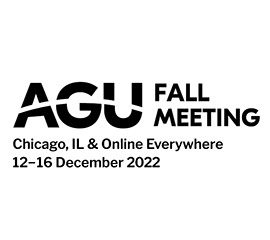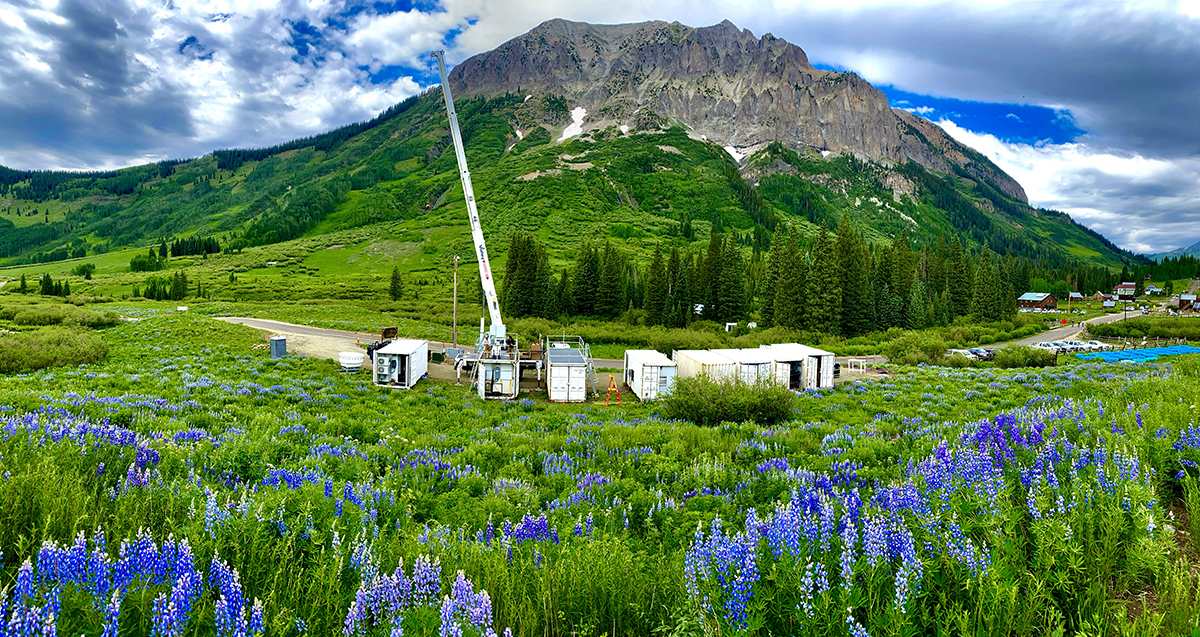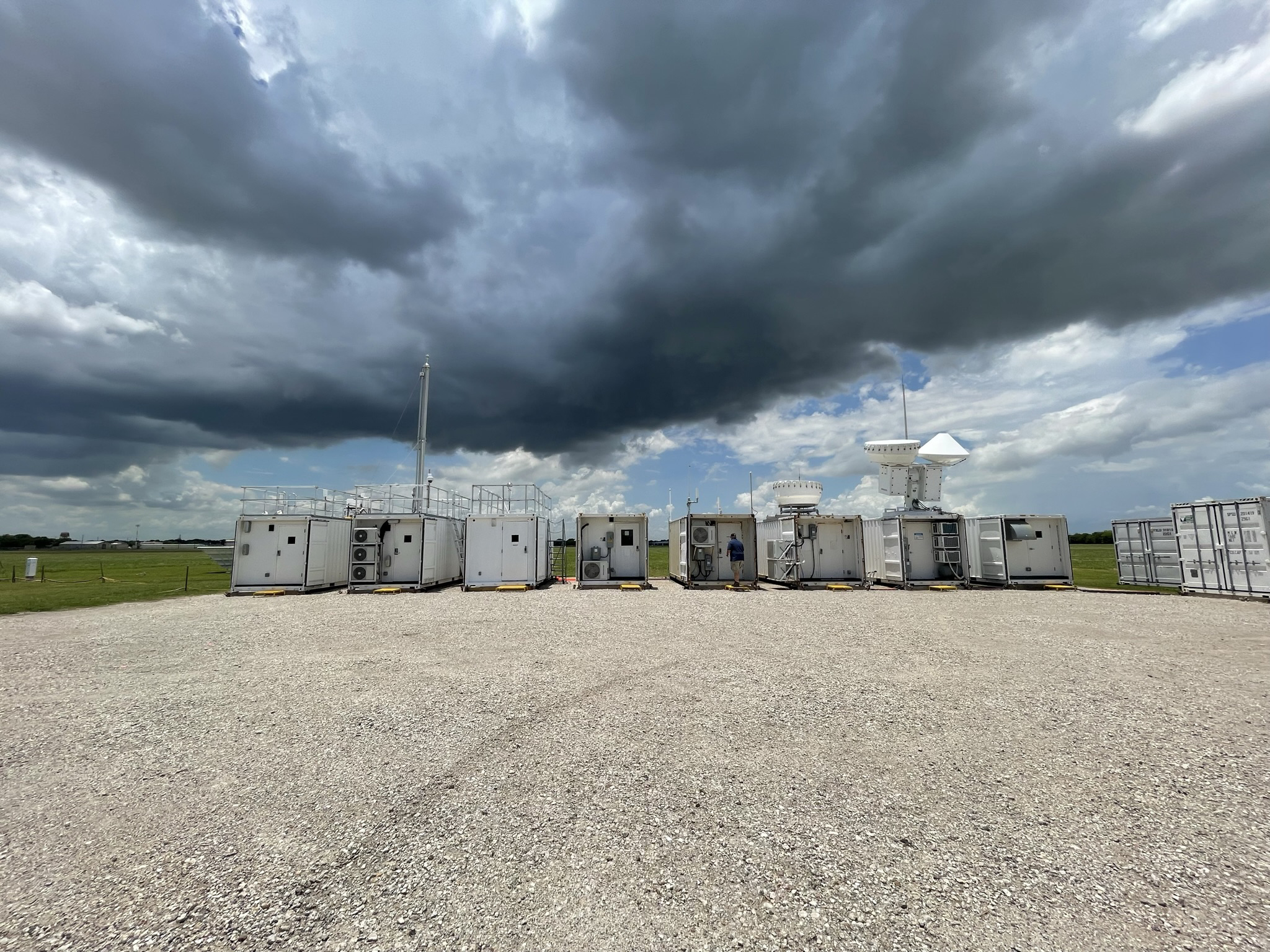2022 AGU Presentations Featuring ARM Data
Published: 20 December 2022
 Editor’s note (December 20, 2022): Registered in-person and virtual attendees of the 2022 American Geophysical Union (AGU) Fall Meeting can log in to the meeting platform to view recorded presentations through February 2023.
Editor’s note (December 20, 2022): Registered in-person and virtual attendees of the 2022 American Geophysical Union (AGU) Fall Meeting can log in to the meeting platform to view recorded presentations through February 2023.
The 2022 American Geophysical Union (AGU) Fall Meeting will be held from December 12 to 16 in Chicago, Illinois, as well as online. With more than 25,000 attendees expected, the meeting might feel overwhelming. We make it easy for you to find ARM-relevant science, meet up with colleagues, and discover new connections during the event.
Below is a list of ARM-related AGU meeting highlights (all times Central). Information is subject to change; please check the AGU Fall Meeting website for the most up-to-date information. Follow us on Twitter (@armnewsteam) and Facebook (@arm.gov) for a real-time guide to relevant activities using the hashtags #ARMAGU and #AGU22.
Go here to find more ARM-related presentations and posters, as well as sessions, talks, and posters related to Atmospheric System Research (ASR).
Add your presentation to be featured on the ARM or ASR presentation web pages.
Attending AGU in person? Make sure to visit the ARM booth in the exhibition hall—Booth 1912. There you can view facility materials, attend flash talks, and meet with ARM representatives.
Agency Lecture
U.S. Department of Energy Office of Science Director Asmeret Asefaw Berhe will speak to AGU 2022’s theme of “Science Leads the Future” on Wednesday, December 14, at 12:45 p.m. at the McCormick Place Grand Ballroom.
Check out ARM’s:
Town Halls
ARM-Related Town Halls
- TH33D: The DOE ARM User Facility: New Capabilities and Establishing Development Priorities
Wednesday, December 14, 12:45–1:45 p.m., McCormick Place – S106a (South, Level 1)
Primary Contact: Jim H. Mather, Pacific Northwest National Laboratory
Presenters: Jennifer M. Comstock, Pacific Northwest National Laboratory; Giri Prakash, Oak Ridge National Laboratory
Other DOE Earth and Environmental Systems Sciences Division Town Halls
- TH13E: Building a More Diverse Scientific Community: Research Opportunities in DOE’s Office of Biological and Environmental Research
Monday, December 12, 12:45–1:45 p.m., McCormick Place – S103ab (South, Level 1)
Primary Contact: Daniel B. Stover, Department of Energy
Presenters: Sally A. McFarlane and Brian Benscoter, Department of Energy
- TH53E: DOE’s Expanded Engagement in Urban Climate Science
Friday, December 16, 12:45–1:45 p.m., McCormick Place – S105a (South, Level 1)
Primary Contact: Jennifer Saleem Arrigo, Department of Energy
Presenters: Gerald L. Geernaert, Department of Energy; Michael P. Jensen, Brookhaven National Laboratory; Jennie Rice, Pacific Northwest National Laboratory
Related Interagency Town Halls
- TH004: NSF AGS Facilities for Atmospheric Research and Education (FARE) Townhall for Broadening Participation
Monday, December 5, 12:45–1:45 p.m., Online only
Primary Contact: Subhashree Mishra, National Science Foundation
Presenters: Subhashree Mishra, National Science Foundation; Gannet Hallar, University of Utah; Bart Geerts, University of Wyoming; Andrew R. Metcalf, Clemson University; Kevin Knupp, University of Alabama in Huntsville
- TH13B: Idealized Modeling Within the Community Earth System Model (CESM) Framework
Monday, December 12, 12:45–1:45 p.m., McCormick Place – S104a (South, Level 1)
Primary Contact: Isla Simpson, National Center for Atmospheric Research
Presenters: Isla Simpson and Scott D. Bachman, National Center for Atmospheric Research
- TH23B: Answering a Call to Action in the Arctic: A Two-Year Plan for Federal Research Investment
Tuesday, December 13, 12:45–1:45 p.m., McCormick Place – S105bc (South, Level 1)
Primary Contact: Liz Weinberg, Interagency Arctic Research Policy Committee
Presenters: Greg J. Anderson, National Science Foundation; Sorina Stalla, Interagency Arctic Research Policy Committee; Suzanne Van Drunick, Environmental Protection Agency; Elizabeth Powers, U.S. Geological Survey; Thomas Douglas, Cold Regions Research and Engineering Laboratory Alaska
- TH23G: Cross-Agency Coordination for Advancing Machine Learning and Artificial Intelligence for Earth System Predictability
Tuesday, December 13, 12:45–1:45 p.m., McCormick Place – S106b (South, Level 1)
Primary Contact: Renu Joseph, Department of Energy
Presenters: Jebb Stewart, NOAA Global Systems Laboratory
- TH33F: Successful Proposal Writing for Early-Career Scientists in Atmospheric Sciences
Wednesday, December 14, 12:45–1:45 p.m., McCormick Place – S105d (South, Level 1)
Primary Contact: Alyssa M. Stansfield, Colorado State University
Presenters: Kenneth W. Jucks, NASA; Sally A. McFarlane, Department of Energy; Monika Kopacz, NOAA; Sylvia A. Edgerton, National Science Foundation
- TH35J: US CLIVAR Town Hall on the Air-Sea Transition Zone
Wednesday, December 14, 6:30–7:30 p.m., McCormick Place – S106a (South, Level 1)
Primary Contact: Michael Patterson, University Corporation for Atmospheric Research
Presenters: Carol Anne Clayson, Woods Hole Oceanographic Institution; Simon P. de Szoeke, Oregon State University
Invited Presentations
Please note: On average, each presentation is scheduled to run no longer than five minutes, so the full session times are listed below for planning purposes.
- A12E-08: Initial Perspectives from the TRACER-UAS campaign. Elizabeth A. Pillar-Little, University of Oklahoma.
Monday, December 12, 9–10:30 a.m., McCormick Place – E258 (Lakeside, Level 2)
- A13A-03: Closing the gap on understudied aerosol-climate processes in the rapidly changing central Arctic. Jessie Creamean, Colorado State University.
Monday, December 12, 11 a.m.–12:30 p.m., McCormick Place – E271ab (Lakeside, Level 2)
- ED16B-01: Successes And Vision For Open Earth Sciences. Scott M. Collis, Argonne National Laboratory.
Monday, December 12, 4:45–6:15 p.m., McCormick Place – N426c (North, Level 4)
- H22F-01: Drivers of snowpack spatial variability in the East River, Colorado: Insights from remote sensing and physically-based modeling. Mark S. Raleigh, Oregon State University.
Tuesday, December 13, 9–10:30 a.m., McCormick Place – E253cd (Lakeside, Level 2)
- H22F-09: From Snowflake to Snowpack: Examining the Consequences of Cloud Microphysical Representations for Hydrologic Uncertainty. Alejandro N. Flores, Boise State University.
Tuesday, December 13, 9–10:30 a.m., McCormick Place – E253cd (Lakeside, Level 2)
- A26C-08: An LES Survey of Cold-Air Outbreaks Spanning ACTIVATE and COMBLE. Ann M. Fridlind, NASA Goddard Institute for Space Studies.
Tuesday, December 13, 4:45–6:15 p.m., McCormick Place – E258 (Lakeside, Level 2)
- GC26G-05: Harmonizing Land and Ocean Surface Radiation Measurements for a More Unified Global Picture of the Surface Radiation Balance. Laura Riihimaki, NOAA/Cooperative Institute for Research in Environmental Sciences.
Tuesday, December 13, 4:45–6:15 p.m., McCormick Place – S406b (South, Level 4)
- A32B-02: Exploring ARM’s Shortwave Spectral Measurements to Quantify Cloud and Aerosol Radiative Effects. Laura Riihimaki, NOAA/Cooperative Institute for Research in Environmental Sciences.
Wednesday, December 14, 9–10:30 a.m., McCormick Place – E258 (Lakeside, Level 2)
- A42C-01: What does it take to predict climate-relevant aerosol properties? Nicole S. Riemer, University of Illinois at Urbana Champaign.
Thursday, December 15, 9–10:30 a.m., McCormick Place – E350 (Lakeside, Level 3)
- A42G-05: Surprises in the Study of Smoke Effects on Shallow Convection: Subsidence, Scavenging, and Cellular Organization. Michael S. Diamond, Cooperative Institute for Research in Environmental Sciences.
Thursday, December 15, 9–10:30 a.m., McCormick Place – E258 (Lakeside, Level 2)
- A45C-01: Towards the development of a baseline in ground-based ice-nucleating particle properties across the world. Naruki Hiranuma, West Texas A&M University.
Thursday, December 15, 2:45–4:15 p.m., McCormick Place – E350 (Lakeside, Level 3)
- A46B-05: Aerosol Growth in the Eastern North Atlantic. Timothy H. Bertram, University of Wisconsin – Madison.
Thursday, December 15, 4:45–6:15 p.m., McCormick Place – E270 (Lakeside, Level 2)
- A56E-01: Particle-resolved modeling: A bridge between scales in aerosol science. Nicole S. Riemer, University of Illinois at Urbana Champaign.
Friday, December 16, 4:45–6:15 p.m., McCormick Place – E354b (Lakeside, Level 3)
- A56C-01: Community effort to build a GeneralIzed Aerosol/chemistry iNTerface (GIANT) for Earth System Models to promote collaborative science. Alma Hodzic, National Center for Atmospheric Research.
Friday, December 16, 4:45–6:15 p.m., McCormick Place – E270 (Lakeside, Level 2)
Featured Field Campaign Presentations
Surface Atmosphere Integrated Field Laboratory (SAIL)

The SAIL field campaign, which kicked off in September 2021 and is set to close operations in June 2023, takes place in the 300-square-kilometer (116-square-mile) East River Watershed near Crested Butte, Colorado. As part of SAIL, a portable ARM observatory is providing valuable atmospheric data that researchers are using to develop detailed measurements of mountainous water-cycle processes as they pertain to the Colorado River, which supplies water for 40 million people in the American West.
Through SAIL, researchers from DOE national laboratories, universities, and research centers and agencies will enable an atmosphere-through-bedrock understanding of mountainous water cycles. NOAA and the National Science Foundation are sponsoring concurrent field studies in the region that will contribute to SAIL research.
SAIL’s lead scientist, Daniel Feldman, will be the primary convener of the following SAIL-related AGU sessions:
- ORAL SESSION—H22F: Atmosphere-Through-Bedrock Observations, Modeling, and Science in the Upper Colorado River Basin I
Tuesday, December 13, 9–10:30 a.m., McCormick Place – E253cd (Lakeside, Level 2)
Reported ARM/DOE SAIL presentations:- H22F-01: Drivers of snowpack spatial variability in the East River, Colorado: Insights from remote sensing and physically-based modeling (Invited). Mark S. Raleigh, Oregon State University.
- H22F-02: Wintertime Precipitation Estimation in the East River Watershed of the Colorado Mountains Using X-Band Radar During SPLASH and SAIL Experiments. Sounak Biswas, Colorado State University.
- H22F-05: Exploring the Properties of Supermicron and Bioaerosol Events during the Surface Atmosphere Integrated Field Laboratory (SAIL) Campaign. Abu Sayeed Md Shawon, Los Alamos National Laboratory.
- H22F-07: Studying Orography-Influenced Riming and Secondary Ice Production and Their Effects on Precipitation Rates Using Radar Polarimetry and Radar Doppler Spectra. Isabelle Steinke, University of Leipzig.
- H22F-08: Quantifying Uncertainties in an Atmosphere-through-Bedrock Integrated Process Model in the Upper Colorado River Basin. Zexuan Xu, Lawrence Berkeley National Laboratory.
- H22F-09: From Snowflake to Snowpack: Examining the Consequences of Cloud Microphysical Representations for Hydrologic Uncertainty (Invited). Alejandro N. Flores, Boise State University.
- POSTER SESSION—H25M: Atmosphere-Through-Bedrock Observations, Modeling, and Science in the Upper Colorado River Basin III
Tuesday, December 13, 2:45–6:15 p.m., McCormick Place – Poster Hall A (South, Level 3)
Reported ARM/DOE SAIL presentations:- H25M-1258: Surveying the First Year of SAIL Data and Formulating Hypotheses for its Second Year. Daniel Feldman, Lawrence Berkeley National Laboratory.
- H25M-1259: The Study of Precipitation, the Lower Atmosphere and Surface for Hydrometeorology (SPLASH) — Outcomes from the first year of observations. Gijs de Boer, University of Colorado Boulder.
- H25M-1262: Dual Doppler Analysis Results from the SPLASH – SAIL Radar Network. V.V. Chandrasekar, Colorado State University.
- H25M-1263: Measurements of Non-refractory Submicron Aerosol Composition and Other Aerosol Properties at a High-Altitude Site in Colorado River Basin. Maria A. Zawadowicz, Brookhaven National Laboratory.
- H25M-1265: Observations of blowing snow at SAIL/SPLASH. Aaron D. Kennedy, University of North Dakota.
- H25M-1266: Radar Observations of Precipitation During SPLASH. Robert Cifelli, NOAA, Physical Sciences Laboratory.
- H25M-1267: SAIL-NET: Investigating spatial variability of aerosol and cloud nuclei in mountainous terrain. Anna L. Hodshire, Handix Scientific.
- H25M-1268 – X-Band Radar Precipitation Estimates for the Surface Atmosphere Integrated Field Laboratory (SAIL) Field Experiment. Joseph Robert O’Brien, Argonne National Laboratory.
TRacking Aerosol Convection interactions ExpeRiment (TRACER)

TRACER, which ran from October 2021 through September 2022, provided convective cloud observations with high space and time resolution over a broad range of environmental and aerosol conditions around the Houston, Texas, region. As part of TRACER, ARM deployed a portable observatory southeast of downtown Houston, a scanning precipitation radar south of downtown, and an ancillary site southwest of the city, where tethered balloon systems were launched. Together, these ARM measurements are helping researchers better understand the variability of aerosols and meteorology between the urban Houston area and surrounding rural environments.
- INVITED ORAL PRESENTATION—A12E-08: Initial Perspectives from the TRACER-UAS campaign. Elizabeth A. Pillar-Little, University of Oklahoma.
Monday, December 12, 9-10:30 a.m., McCormick Place – E258 (Lakeside, Level 2)
- ORAL SESSION—A13B: Air Quality Trends and Challenges in Urban Area II
Monday, December 12, 11 a.m.–12:30 p.m., McCormick Place – E450a (Lakeside, Level 4)
Reported TRACER presentations:- A13B-05: Observation of pollution events at low altitude during TRACER-AQ — the advantage of adaptive resolution lidar. Guillaume Gronoff, Science Systems and Applications Inc.
- POSTER SESSION—A25G: Air Quality Trends and Challenges in Urban Area V
Tuesday, December 13, 2:45–6:15 p.m., McCormick Place – Poster Hall A (South, Level 3)
Reported TRACER presentations:- A25G-1789: An Evaluation of Lidar Derived Ozone Curtain Profiles from the TRACER-AQ Campaign and WRF-Chem Simulation. Claudia Bernier, University of Houston.
- A25G-1791: Analyzing Transport Pattern of Air Pollutants During the TRACER-AQ 2021 Campaign in Houston, Texas. Ehsan Soleimanian, University of Houston.
- A25G-1803: Evaluating WRF offshore meteorology simulation during TRACER-AQ 2021 in Houston, TX. Xueying Liu, University of Houston.
- A25G-1804: Evaluating WRF-CAMx offshore ozone simulation during TRACER-AQ 2021 in Houston, TX. Wei Li, University of Houston.
- ONLINE POSTER SESSION—A31I: Light-Absorbing Carbon Aerosol from Observations and Models I
Wednesday, December 14, 8–9 a.m., Online only
Reported TRACER presentations:- A31I-03: Impact of humidification on ambient aerosol optical properties; Field observations from TRACER-CAT in Houston, TX. Rachael Dal Porto, University of California Davis.
- POSTER SESSION—A32I: Light-Absorbing Carbon Aerosol from Observations and Models II
Wednesday, December 14, 9 a.m.–12:30 p.m., McCormick Place – Poster Hall A (South, Level 3)
Reported TRACER presentations:- A32I-1497: Mixed Carbon Aerosol Properties in Houston, TX (TRACER-CAT): Role of chemistry in absorption, scattering, and humidification. James Edward Lee, Los Alamos National Laboratory.
- ORAL SESSION—A42C: Atmospheric Aerosols and Their Interactions with Clouds, Radiation, and Climate III
Thursday, December 15, 9–10:30 a.m., McCormick Place – E350 (Lakeside, Level 3)
Reported TRACER presentations:- A42C-06: Chemistry of nonrefractory submicron aerosol in urban industrialized Texas: first results from TRACER. Maria A. Zawadowicz, Brookhaven National Laboratory.
- A42C-07: Characterization of New Particle Formation Events During the TRACER Campaign. Tamanna Subba, Brookhaven National Laboratory.
- POSTER SESSION—A45M: Convection Processes and Their Environmental and Aerosol Interactions: Theory, Observation, and Modeling III
Thursday, December 15, 2:45–6:15 p.m., McCormick Place – Poster Hall A (South, Level 3)
Reported TRACER presentations:- A45M-2021: Summary of Deep Convective Cloud Cases Observed During the TRacking Aerosol Convection interactions ExpeRiment (TRACER) Intensive Operational Period. Michael P. Jensen, Brookhaven National Laboratory.
- A45M-2024: Life cycle of deep convective clouds in the Houston, TX region. Dié Wang, Brookhaven National Laboratory.
- A45M-2031: Agile Adaptive Polarimetric Radar Observations of Isolated Convective Cells from the TRACER and ESCAPE field campaigns. Jason Barr, Stony Brook University.
Multidisciplinary Drifting Observatory for the Study of Arctic Climate (MOSAiC)

The massive MOSAiC expedition set out to document the atmosphere, sea ice, ocean, biogeochemistry, and ecosystem in the central Arctic. More than 400 field participants and 60 institutions from 20 countries were active in the German-led expedition from September 2019 to October 2020. MOSAiC’s central observatory was the icebreaker R/V Polarstern, which froze into and then drifted with the arctic sea ice for most of the year. ARM provided the most atmospheric instruments—more than 50—to the expedition.
- INVITED ORAL PRESENTATION—A13A-03: Closing the gap on understudied aerosol-climate processes in the rapidly changing central Arctic. Jessie Creamean, Colorado State University.
Monday, December 12, 11 a.m.–12:30 p.m., McCormick Place – E271ab (Lakeside, Level 2)
- ORAL SESSION—C23B: The Changing Arctic Seas: Weather System Amplifiers? II
Tuesday, December 13, 11 a.m.–12:30 p.m., McCormick Place – S504d (South, Level 5)
Reported MOSAiC presentations:- C23B-07: Arctic Cyclone Mesoscale Features Producing Thermodynamic Impacts during MOSAiC. Ola P.G. Persson, Cooperative Institute for Research in Environmental Sciences/University of Colorado Boulder/NOAA.
- ORAL SESSION—A33F: Microphysical and Macrophysical Properties and Processes of Ice and Mixed-Phase Clouds: Linking in Situ and Remote Sensing Observations and Multiscale Models
Wednesday, December 14, 11 a.m.–12:30 p.m., McCormick Place – E353ab (Lakeside, Level 3)
Reported MOSAiC presentations:- A33F-02: Multilayer Mixed-phase Cloud Interactions Modelled based on Observations during MOSAiC and MOSAiC-ACA. Jan Chylik, University of Cologne.
Matthew Shupe, a DOE-funded principal investigator and a co-coordinator of the MOSAiC expedition, will be the primary convener of the following MOSAiC- and Arctic-themed AGU sessions:
- ORAL SESSION—C42A: Coupled-System Processes of the Central Arctic Atmosphere-Sea Ice-Ocean System: Harnessing Field Observations and Advancing Models
Thursday, December 15, 9–10:30 a.m., McCormick Place – S505ab (South, Level 5)
Reported MOSAiC presentations:- C42A-05: Snow Thermal Conductivity and Conductive Flux Variability During the MOSAiC Winter. Anne Sledd, Cooperative Institute for Research in Environmental Sciences/University of Colorado Boulder/NOAA.
- C42A-06: Melt onset at MOSAiC: Resiliency of the ice column to preconditioning by warming extremes. Christopher Cox, NOAA.
- ORAL SESSION—C43A: Coupled-System Processes of the Central Arctic Atmosphere-Sea Ice-Ocean System: Harnessing Field Observations and Advancing Models II
Thursday, December 15, 11 a.m.–12:30 p.m., McCormick Place – S505ab (South, Level 5)
Reported MOSAiC presentations:- C43A-04: Potential Influence of Siberian River Water on Marine and Sea-ice Biology and Biogeochemical Cycles during the MOSAiC Drift Campaign. Georgi Laukert, Dalhousie University.
- C43A-07: Perspectives on the Scaling Relationships between Summertime Surface Albedo and Melt Pond Fraction in the Central Arctic Ocean from Uncrewed Aircraft Systems. Radiance Calmer, University of Colorado Boulder.
- POSTER SESSION—C45C: Coupled-System Processes of the Central Arctic Atmosphere-Sea Ice-Ocean System: Harnessing Field Observations and Advancing Models III
Thursday, December 15, 2:45–6:15 p.m., McCormick Place – Poster Hall A (South, Level 3)
Reported MOSAiC presentations:- C45C-1093: Aerosol Trace Element Concentrations and Fractional Solubility During Legs 2 and 3 of the MOSAiC Campaign. Chris Marsay, Skidaway Institute of Oceanography.
- C45C-1094: Air-ice-ocean Interactions at MOSAiC from Select Events. Ola P.G. Persson, Cooperative Institute for Research in Environmental Sciences/University of Colorado Boulder/NOAA.
- C45C-1098: Cloud Macro- and Microphysical Properties as Coupled to Sea Ice Leads During the MOSAiC Expedition. Pablo Saavedra Garfias, University of Leipzig.
- C45C-1100: Partitioning cloud impacts on the central Arctic surface energy budget. Matthew Shupe, Cooperative Institute for Research in Environmental Sciences/University of Colorado Boulder/NOAA.
- C45C-1108: Towards a more realistic representation of NASA CERES-derived surface radiative fluxes during polar night: a comparison with the MOSAiC field campaign. Jason Brant Dodson, NASA Langley Research Center.
- C45C-1111: Wind and Turbulence Characteristics along the Flight Paths of the Helicopter-Borne Probe HELiPOD during the MOSAiC Expedition. Magnus Ole Asmussen, Technische Universität Braunschweig.
Keep up with the Atmospheric Observer
Updates on ARM news, events, and opportunities delivered to your inbox
ARM User Profile
ARM welcomes users from all institutions and nations. A free ARM user account is needed to access ARM data.


















